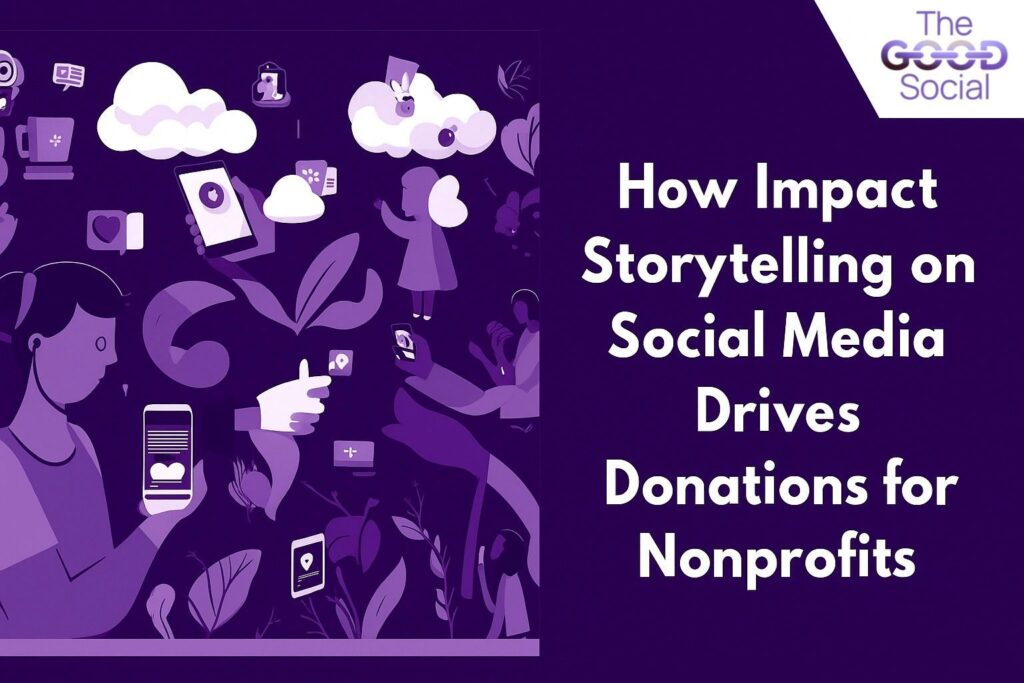Have you ever stopped to think about what makes a donation truly meaningful? Is it just the act of giving, or is it the story behind the cause that inspires someone to take action?
For nonprofits, the power to evoke emotion, spark empathy, and encourage action lies in one powerful tool: Impact Storytelling. And what better platform to do this than on social media?
With the rise of online fundraising for nonprofits and the increasing reliance on social fundraising platforms, storytelling has become a crucial strategy. It’s no longer just about asking for donations; it’s about sharing stories that resonate with the heart and soul of potential supporters.
What is Impact Storytelling?
Before we delve into why it’s so effective, let’s clarify what Impact Storytelling means. At its core, it’s about weaving a compelling narrative that highlights the real-life impact of your nonprofit’s work. It’s not just about numbers or statistics; it’s about sharing human experiences that inspire your audience to get involved.
For example, if your nonprofit works on providing clean water to underserved communities, storytelling might involve sharing the journey of a community whose lives have been transformed by access to clean water. It’s personal, relatable, and emotionally charged—ultimately compelling your audience to act.
Why Does Impact Storytelling Matter for Nonprofits?

Nonprofits, especially those relying on online fundraising for nonprofits, must capture the attention of their audience in a noisy, fast-paced social media world.
Impact storytelling allows you to stand out, connect emotionally, and build trust.
Here’s why it works:
- Creates Emotional Connections: Stories make people feel. When you can tap into emotions, your message resonates more deeply, creating a stronger connection between your cause and potential donors.
- Simplifies Complex Issues: Not every cause is easy to understand. By telling a relatable story, you can simplify complex issues and make your message more accessible.
- Increases Engagement: People are more likely to engage with content that tells a story than content that simply asks for a donation. Engaged audiences are more likely to contribute and share your message, further expanding your reach.
How Does Storytelling Drive Donations on Social Media?
Now that we understand what impact storytelling is, let’s explore how it can specifically drive donations for your nonprofit on social media.
1. Builds Trust with Your Audience: Trust is the cornerstone of any donation. Donors want to know that their money is going to make a real difference. When you share stories of the people your nonprofit is helping, it shows transparency and accountability. You’re not just asking for funds; you’re showing the impact that donation will have.
Pro tip: Share updates on past projects, showing how previous donations have made a tangible difference. This will build credibility and encourage repeat donations.
2. Encourages People to Share Your Cause: One of the best things about social media is its ability to amplify your message. Impact stories are highly shareable because they evoke emotion and inspire action. When people feel connected to a story, they want to spread it to others, creating a ripple effect.
Your supporters will be more likely to share a heartwarming story of a family who benefited from your nonprofit’s work than a simple donation ask. Social Media Fundraising Strategies should include compelling stories that your audience will want to share with their own networks, expanding your reach far beyond your immediate followers.
3. Inspires Action: A good story motivates. When you show the real-life consequences of a problem, you make the need for help undeniable. Whether it’s a child in need of education, a community needing clean water, or an animal in need of rescue, storytelling gives your cause a face, making it harder for potential donors to look away.
What’s even more powerful is when you include a call-to-action at the end of the story—like a link to donate, volunteer, or share the message. This clear, actionable step can turn passive viewers into active supporters.
4. Brings Your Nonprofit’s Mission to Life: People don’t donate to causes; they donate to the stories behind those causes. Think about it: If your social media post simply says, “We need donations for clean water projects,” it’s easy to overlook. But if you share the story of a young girl whose life was changed because she gained access to clean water through your nonprofit’s work, it’s much harder to ignore.
5. Uses Visual Content to Enhance the Story: The saying “a picture is worth a thousand words” holds true in social media fundraising. Visual content, such as photos and videos, can enhance the storytelling experience, making the impact of your cause even more tangible.
Tip: Use before-and-after images, videos of people benefiting from your programs, or testimonials from beneficiaries to make your story even more compelling.
Social Media Fundraising Strategies: Using Stories to Maximize Donations

Now that we know storytelling is a powerful tool, how can you leverage it effectively within your social media fundraising strategies?
Here are some tips to help you make the most out of your impact stories:
1. Know Your Audience: Tailor your stories to the people you are trying to reach. If your primary audience is young adults, using short, engaging videos might be the way to go.
For older, more established donors, a heartfelt written story with powerful imagery might resonate more
2. Incorporate User-Generated Content: Encourage your supporters to share their own stories and experiences with your nonprofit. User-generated content adds authenticity and shows that your impact is real, coming from people who have directly engaged with your cause.
3. Use Hashtags to Amplify Reach: Hashtags are essential for getting your story discovered on social media. By using relevant, popular hashtags related to your cause or nonprofit industry, you can increase the visibility of your posts and encourage more donations.
4. Leverage Stories Across Platforms: Don’t limit your storytelling to just one social media platform. Use Facebook, Instagram, Twitter, and even LinkedIn to share stories in different formats. Each platform offers unique ways to reach different audiences, so it’s important to be versatile in how you tell your story.
5. Engage with Your Audience: Don’t just post stories and forget about them. Engage with your audience in the comments, thank them for sharing, and encourage them to spread the word. The more you interact with your followers, the more they’ll feel personally invested in your cause.
Conclusion: The Power of Storytelling to Drive Donations
In the world of social fundraising platforms and online fundraising for nonprofits, storytelling is a powerful tool that can transform the way you engage with donors. Through emotional, compelling narratives, you can create deep connections with your supporters, build trust, and inspire them to act.
So, what story will you share next? Will it be the story of a life changed, a community empowered, or a cause that needs your support?
At the end of the day, storytelling to drive donations is about more than just raising money; it’s about creating lasting relationships and turning supporters into passionate advocates for your cause. When done right, the stories you tell today can inspire the donations of tomorrow.
Let your story be the spark that drives change and empowers your nonprofit to continue making a difference. The future of fundraising is here, and it’s told through stories.

